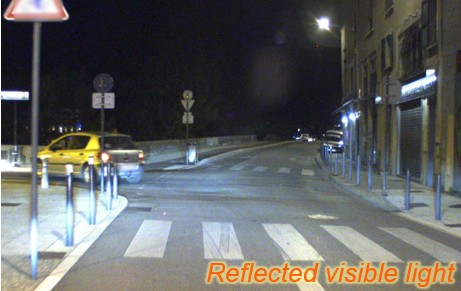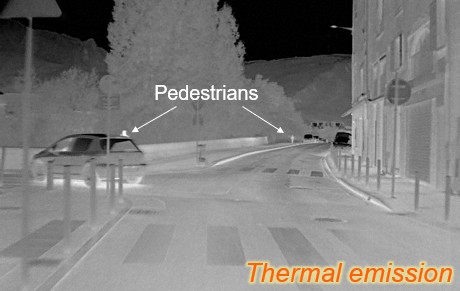On October 8th, 2025, Principal Optical Systems Engineer, Kevin Sweeney presented at AutoSens Europe about the challenges the automotive sector is facing with thermal imaging technology. As more than 28 million cars worldwide are now equipped with advanced driver assistance systems (ADAS) that use thermal sensors[1], Kevin’s insights come at the right time to break new ground for IR systems used on vehicles. Here is what you should know about the current paradigm shift in the industry:
Thermal cameras for the automotive sector are here to stay
Traditionally, thermal imaging has been linked to defense and military deployments, with a strong secondary presence in industrial and manufacturing applications. But recent developments in the automotive sector are changing this landscape, as manufacturers are increasingly adopting thermal imaging for advanced driver assistance systems and autonomous vehicles. People are even taking to Reddit to plug this technology onto their cars. According to a 2025 Verified Market Reports analysis of automotive thermal camera trends, “The automotive thermal camera segment is exhibiting a compound annual growth rate of 15.5% from 2026 to 2033, reflecting accelerated adoption across vehicle safety and autonomous driving systems.”
As driving systems become smarter and more widespread, they need to be fed the best data, including premium-quality visual inputs. This emphasizes the usefulness of thermal imaging for its ability to detect heat signatures in complete darkness and adverse weather conditions where traditional cameras fail. Even from the floors of the Optikos manufacturing facility, we have noticed a 3x increase in interest for LWIR LensCheck™ testing for the automotive market, a trend that falls precisely in line with the overall market growth.
As Kevin pointed out in his talk about the significance of this trend,
Nascent adoption of thermal imaging by the automotive industry presents a new challenge by requiring the production of these devices in historically high quantities. In addition to manufacturing capacity and pricing pressure, the ability to test performance with reliable instrumentation will also be critical to ensure that acceptance criteria are correctly applied.”
Testing cameras is a must, but what exactly should you test?
This is the key question Kevin raised during his AutoSens presentation. So far, automotive manufacturers have relied primarily on spatial frequency response measurements like Modulation Transfer Function (MTF) to evaluate thermal cameras. However, MTF focuses mainly on image resolution and doesn’t tell the complete story. The challenge is that people should not think of a thermal camera as a device that can just “see” temperature. That sort of analogy is misleading as no object emits thermal radiation with 100% efficiency (a concept known as emissivity), resulting in contrast loss between objects and their environment separate from MTF-related losses. Instead, the system should be understood as something that detects and resolves thermal radiation contrast differences between objects and their environment. This automatically translates into searching for more sophisticated and applicable evaluation metrics.
Kevin’s proposal for automotive manufacturers is to pay closer attention to more comprehensive metrics like Minimum Detectable Temperature Difference (MDTD) and Minimum Resolvable Temperature Difference (MRTD). These indicators evaluate the camera’s ability to detect and resolve actual thermal contrast, which is the fundamental feature that makes thermal imaging useful in real-world driving conditions.
In MRTD/MDTD test setups, ignoring factors like test source emissivity risks introducing systematic errors that can significantly affect apparent manufacturing yield down the line. As such, next generation test sources combining calibrated emissivity with high-speed testing capability will be a crucial next big step for the ADAS industry.
Start unlocking quality image KPIs through available technology
The Optikos solution for testing automotive thermal cameras draws directly from proven methodologies in the defense sector. “As thermal imaging gains traction in developing better automotive safety systems, we can take advantage of lessons learned and techniques developed by the defense industry. Infrared radiometers have served this sector for decades, usually for characterizing test setups that were designed for larger thermal cameras than those required for light vehicles. Since radiometers are generally sized according to the scale of the camera that will eventually be tested, the primary challenge is the miniaturization of the existing detection schemes.”
Infrared radiometers, which are devices that characterize the relationship between radiometric temperature (what the camera “sees”) and the physical temperature of a radiation source, are essential tools for this new way of testing thermal cameras on vehicles. At Optikos, we are currently looking into our past devices such as the RAD-900 model that accurately measures how radiometric temperature variations relate to actual physical temperature differences in thermal target systems. The device was an essential tool for getting a complete thermal-imager testing analysis and is now the base for thermal camera testing developments in the company.
The automotive industry’s embrace of thermal imaging represents more than just adding another sensor to its builds. What we’re witnessing is a fundamental shift in how vehicles can interact with their environment. Kevin’s presentation at AutoSens Europe made clear that success in this space demands a complete rethinking of how we test and validate these critical safety systems.
By adopting defense-proven testing methodologies and focusing on metrics like MDTD and MRTD rather than relying solely on MTF, manufacturers can ensure their thermal cameras deliver the contrast detection capabilities that truly matter on the road. Our biggest take from the conference? The paradigm shift is here. The question is no longer whether thermal imaging belongs with vehicles, but whether we’re testing it correctly to unlock its full potential.


Want to dive deeper?
Here are a few more articles from the Optikos team that you might find valuable:
Click here to learn more about Optikos solutions for automotive imaging
[1] https://www.industryresearch.biz/market-reports/thermal-imaging-market-108495




